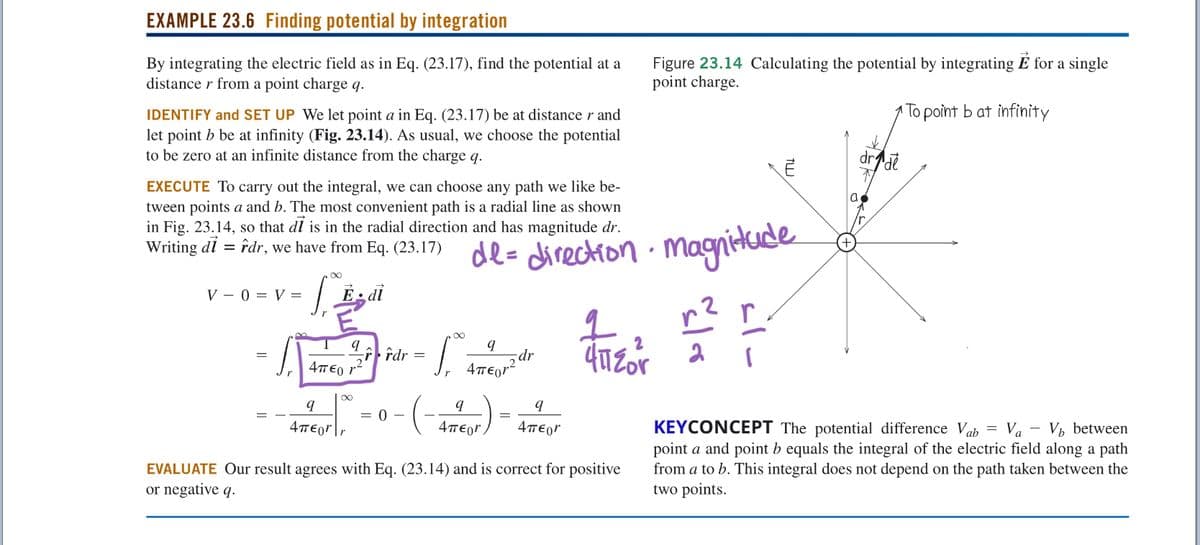By integrating the electric field as in Eq. (23.17), find the potential at a distance r from a point charge q. IDENTIFY and SET UP We let point a in Eq. (23.17) be at distance r and let point b be at infinity (Fig. 23.14). As usual, we choose the potential to be zero at an infinite distance from the charge q. EXECUTE To carry out the integral, we can choose any path we like be- tween points a and b. The most convenient path is a radial line as shown in Fig. 23.14, so that dl is in the radial direction and has magnitude dr. Writing di = fdr, we have from Eq. (23.17) de= direction V - 0 = V = E; di 2 L rdr dr 4TEor = 0 4TEor, 4TEor, 4TEor
By integrating the electric field as in Eq. (23.17), find the potential at a distance r from a point charge q. IDENTIFY and SET UP We let point a in Eq. (23.17) be at distance r and let point b be at infinity (Fig. 23.14). As usual, we choose the potential to be zero at an infinite distance from the charge q. EXECUTE To carry out the integral, we can choose any path we like be- tween points a and b. The most convenient path is a radial line as shown in Fig. 23.14, so that dl is in the radial direction and has magnitude dr. Writing di = fdr, we have from Eq. (23.17) de= direction V - 0 = V = E; di 2 L rdr dr 4TEor = 0 4TEor, 4TEor, 4TEor
Principles of Physics: A Calculus-Based Text
5th Edition
ISBN:9781133104261
Author:Raymond A. Serway, John W. Jewett
Publisher:Raymond A. Serway, John W. Jewett
Chapter20: Electric Potential And Capacitance
Section: Chapter Questions
Problem 82P
Related questions
Question
Im having trouble inegrating dr

Transcribed Image Text:EXAMPLE 23.6 Finding potential by integration
By integrating the electric field as in Eq. (23.17), find the potential at a
distance r from a point charge q.
Figure 23.14 Calculating the potential by integrating É for a single
point charge.
'To point b at infinity
IDENTIFY and SET UP We let point a in Eq. (23.17) be at distance r and
let point b be at infinity (Fig. 23.14). As usual, we choose the potential
to be zero at an infinite distance from the charge q.
drae
EXECUTE To carry out the integral, we can choose any path we like be-
tween points a and b. The most convenient path is a radial line as shown
in Fig. 23.14, so that di is in the radial direction and has magnitude dr.
di = îdr, we have from Eq. (23.17) de= direction
Writing . magnitose
V – 0 = V =
E; di
r? r
f îdr =
Eor
-dr
4T€0 r²
4TEor2
= 0
KEYCONCEPT The potential difference Vab = Va – V½ between
point a and point b equals the integral of the electric field along a path
from a to b. This integral does not depend on the path taken between the
two points.
4T€0",
4περΓ
EVALUATE Our result agrees with Eq. (23.14) and is correct for positive
or negative q.
Expert Solution
This question has been solved!
Explore an expertly crafted, step-by-step solution for a thorough understanding of key concepts.
This is a popular solution!
Trending now
This is a popular solution!
Step by step
Solved in 2 steps with 2 images

Knowledge Booster
Learn more about
Need a deep-dive on the concept behind this application? Look no further. Learn more about this topic, physics and related others by exploring similar questions and additional content below.Recommended textbooks for you

Principles of Physics: A Calculus-Based Text
Physics
ISBN:
9781133104261
Author:
Raymond A. Serway, John W. Jewett
Publisher:
Cengage Learning

Physics for Scientists and Engineers, Technology …
Physics
ISBN:
9781305116399
Author:
Raymond A. Serway, John W. Jewett
Publisher:
Cengage Learning

Physics for Scientists and Engineers with Modern …
Physics
ISBN:
9781337553292
Author:
Raymond A. Serway, John W. Jewett
Publisher:
Cengage Learning

Principles of Physics: A Calculus-Based Text
Physics
ISBN:
9781133104261
Author:
Raymond A. Serway, John W. Jewett
Publisher:
Cengage Learning

Physics for Scientists and Engineers, Technology …
Physics
ISBN:
9781305116399
Author:
Raymond A. Serway, John W. Jewett
Publisher:
Cengage Learning

Physics for Scientists and Engineers with Modern …
Physics
ISBN:
9781337553292
Author:
Raymond A. Serway, John W. Jewett
Publisher:
Cengage Learning

Physics for Scientists and Engineers
Physics
ISBN:
9781337553278
Author:
Raymond A. Serway, John W. Jewett
Publisher:
Cengage Learning


College Physics
Physics
ISBN:
9781285737027
Author:
Raymond A. Serway, Chris Vuille
Publisher:
Cengage Learning